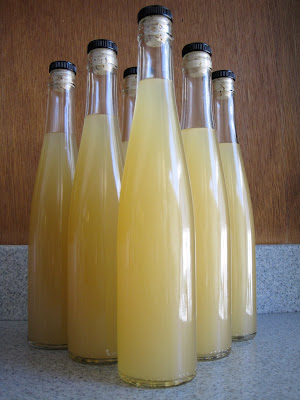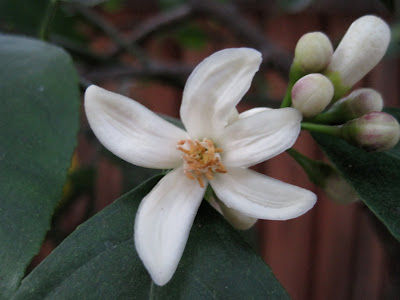Infusing is a great way to get the absolute most out of the food on hand. Rather than tossing those lemon peels, make lemon infused vodka for use in cocktails. Rather than tossing that extra tarragon, infuse a white wine vinegar.
The possibilities are limited only by your imagination. (I was
shocked to find many references to, and recipes for,
bacon-infused vodka on the web.) Here are some excellent references on infusion:
In early March of this year, we blogged about our Meyer Lemon tree in
Spring in Silicon Valley. We had a tree full of lemons and needed to find a way to preserve them. One option we chose was juicing them, saving the peels to infuse Everclear as a base for limoncello. We are so happy we did!
Limoncello is traditionally served after dinner as a
digestif or alongside a dessert course. A great general reference on limoncello can be found on
Life in Italy. Take note of this quote:
"One sips limoncello slowly, not all at one time as a shot."
I laughed out loud when I read this, but limoncello
is a potent liqueur. Ours is based on
Everclear, which weighs in at 151
proof. Needless to say, limoncello should be consumed in very small quantities.
Here's our recipe:
Meyer Limoncello
Makes 1.25 liters
750ml Everclear (can substitute vodka if Everclear unavailable in your area)
10 Meyer lemons
2c water
2c sugar
Using a vegetable peeler, remove the zest from the lemons (avoiding the white pith). Place the lemon zest and the Everclear in a glass jar and allow to sit in a cool, dark place for 30 days, stirring daily. (Ensure the jar prevents evaporation; we used the Le Parfait 2 liter glass canning jar ). At 30 days, begin testing the zest by removing a piece from the mash. If it breaks when bent, the mixture is ready for the next step. If it simply bends, return the mixture to the cool, dark place. Test weekly.
). At 30 days, begin testing the zest by removing a piece from the mash. If it breaks when bent, the mixture is ready for the next step. If it simply bends, return the mixture to the cool, dark place. Test weekly.
When ready, strain the alcohol and discard the zest. Create a simple syrup by combining the sugar and water in a saucepan over high heat. Stir frequently until sugar dissolves completely. Add the simple syrup to the infused alcohol. Bottle and refrigerate till cold. Limoncello is best stored in the freezer till ready for use.

We let our mash rest for 3 months. The infused Everclear was a deep golden yellow and fairly clear. The peels were still flexible, but had lost much of their color.
When we added the simple syrup, the mixture was a milky, lemony yellow. Since we were hoping for a clearer product, we filtered the limoncello, using a
fine mesh strainer
lined with a standard coffee filter. (This didn't make much of a difference in the color, but it did taste
much smoother afterward.) From there the limoncello went into the freezer to chill.
We had our first glass last night and it was amazing. When tried side by side with Nardini's
Acqua Di Cedro, it showed well: much less cloying and much more refreshing. Excellent lemon aroma and flavor, with the sweetness balanced by a bit of tartness.
Next weekend we're going to try a pairing of this limoncello with Salmon Piccata /
Seitan Piccata.

















